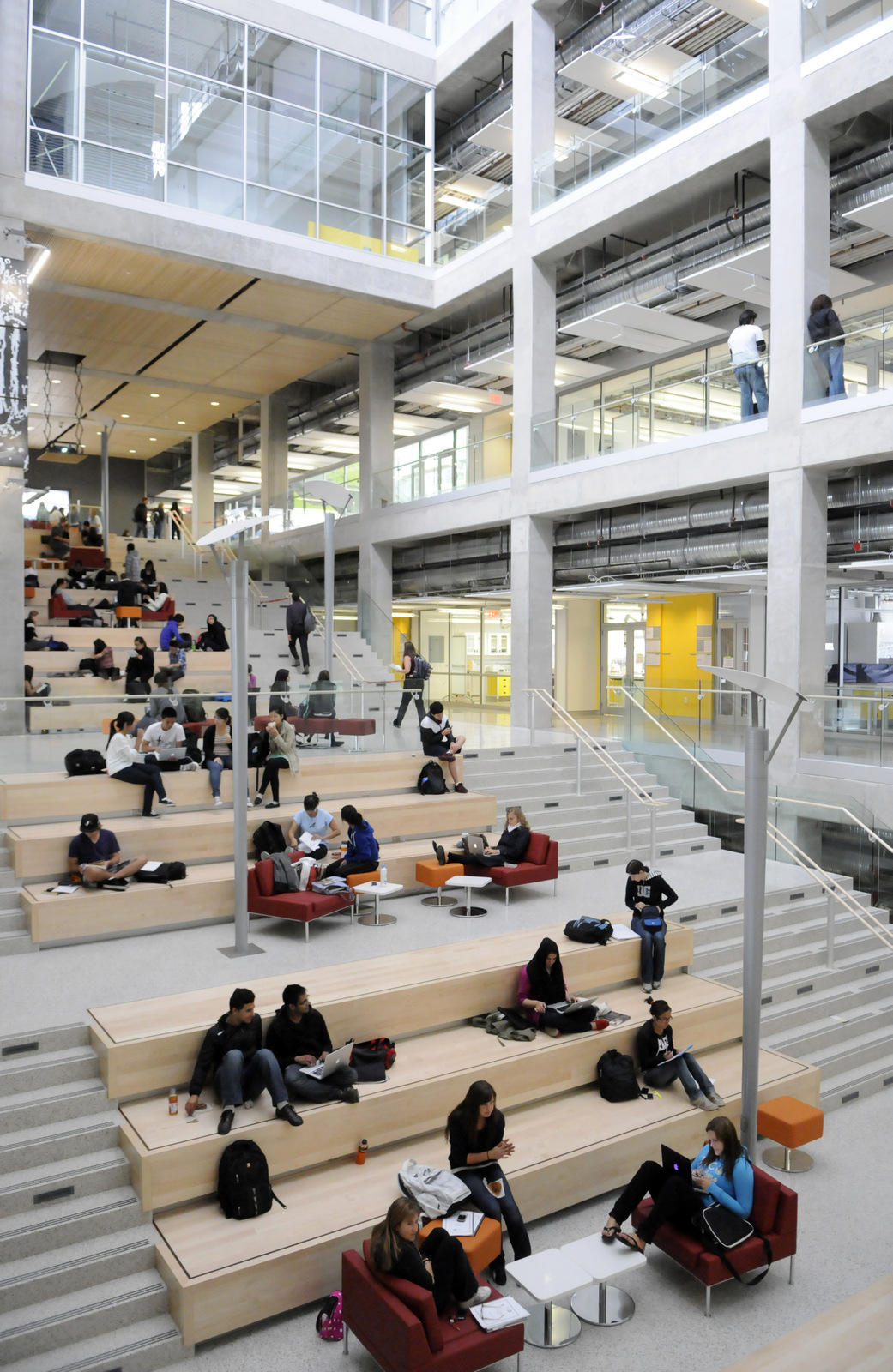Nov. 13, 2014
Smart, innovative EEEL building a perfect venue for TEDxCalgary

Inspired by other iconic stairs, EEEL’s grand staircase is a natural meeting area.
This weekend, TEDxCalgary will join the long list of estimable events and individuals who have made a stop in the renowned Energy Environment Experiential Learning (EEEL) building on campus.
One of the most energy-efficient laboratory buildings in North America, the EEEL building is known for its smart design, green features and pioneering architecture and engineering, and has attracted students, politicians and community leaders to its halls since it opened its doors in 2011.
On Nov. 15 the certified LEED-platinum building will host a few hundred people for TEDxCalgary Truth(s). Calgarians will congregate around the atrium staircase to share ideas worth spreading, about truths that are universal, debatable, hard and necessary. The interplay between theme and venue has never been stronger.
“The TED in TEDxCalgary stands for Technology Entertainment and Design, and the ‘x’ to us represents the unknown,” says Rahim Sajan, co-founder and curator of TEDxCalgary. “The EEEL building is a direct link to all four of those aspects of what TEDx stands for to us. We work very hard to make sure that the events are taking place in a place that has its own voice.”
Sajan recalls first visiting the EEEL building a few years ago and says he was blown away by the incredible design of the building, particularly the great stairs. “Over the years, I kept coming back to those stairs as a place we needed to convene people around.”
While an unconventional theatre space, EEEL is a venue that echoes with parallels to TEDxCalgary’s theme this year.
In the spirit of discovering truths, the University of Calgary’s Adam Stoker, sustainability consultant with the Office of Sustainability and Jon Greggs, director of campus planning, share their insights on both the EEEL building and TEDxCalgary.
Transparency is at the core of the building’s design
The 25,000-square-metre building emphasizes visibility and transparency through strategically placed windows and floor-to-ceiling interior glass walls. Exterior windows are triple-glazed for insulation; labs and classroom spaces have clear views of the outdoors as well as the interior public corridors.
“When you’re outside on the street, you can see into this building,” says Greggs. “You can see lab activity but also, the windows let daylight in.” Walk by labs and you’ll see translucent projection screens that are visible to passersby so they are immediately exposed to what’s going on in learning spaces.
The grand staircase atrium is fashioned after a village square
EEEL is equal parts instruction space, teaching labs as well as community gathering areas to facilitate social interchange and self-directed collaboration. Inspired by other iconic stairs like the Chicago Institute of Art stairs and the Spanish Steps in Rome, EEEL’s grand staircase is a natural meeting area.
“We wanted a staircase that was inviting, easy to find and potentially a signature element to the building,” says Greggs. “It’s like the village square. Some days, it’s the market; other days, the politicians are speaking. The staircase becomes the village street, fanning out into the community and each of the classrooms and laboratories are like a dwelling.”
EEEL uses half the energy required for comparable buildings
With smart technology like automatic lighting that senses daylight and occupancy, EEEL saves on its electricity bill, big time. In EEEL, you are in fact the light switch. “Because we have new people in the building every day, we use sensors to automatically turn lights on and off instead of a traditional light switch," says Stoker. The large moveable shades on the exterior windows are controlled by the building’s computer system and open and close by sensing the amount of heat through indoor and outdoor temperatures. With the “streetlamps” in the staircase atrium, there is also no need to spend as much energy lighting the whole five-story space with overhead lights.
Art and science coexist in this modern space
One of the most striking features in the atrium is a towering silver-leaf tree art piece created on several four- by eight-foot etched steel panels mounted on the elevator shaft. Created by Marjan Eggermont, a renowned printmaker and University of Calgary engineering faculty member, the artwork is just one of the commissioned pieces that was part of the deliberate decision to bring the arts into a building that’s mainly focused on science and engineering.
Water efficiency is through the roof. Literally
If you’re using the washrooms in EEEL, you’ll be happy to know that the water in the toilets and urinals is captured rainwater run through filters and collected from the roof of the building. “When you first cut your water consumption by using low-flow plumbing fixtures, it opens up possibilities for innovation,” says Stoker. Sustainable water practices such as these allows EEEL to reduce its potable water use by 64 per cent.
The space is built to adapt, change and to be flexible
“You want to think about accommodating current pedagogical models and also how the building will be asked to change over time,” says Greggs. “A classroom today can be a lab tomorrow.” To this end, EEEL is future-proofed to be completely convertible so rooms have been built with floor drains and electrical panels already to go for full lab conversions. All the services and structural components run through the corridors and have exposed pipes for easy access and maintenance.
